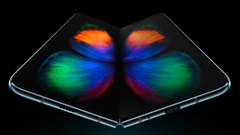
Samsung has been copping a lot of flak for the highly publicized issues that some of the Galaxy Fold review units it has in circulation. However, some of these critics fail to adequately credit Samsung for pushing the boundaries of what is possible. Note: The views expressed here represent the views of the author alone and don't necessarily reflect the views of Notebookcheck.
The internet has exploded over the apparent issues Samsung has been experiencing with the displays on a handful of Galaxy Fold review units. Undoubtedly, it is an embarrassing situation for the company to be in. After all, it is a marquee product and one that is meant to be a beacon of the technical expertise and innovation of which only Samsung is capable. Remember, however, it was only in 2017 that Apple launched one of the first “full screen” phones on the market with the iPhone X, but here we are in the first half of 2019 with the first foldable phone from Samsung. This is a major accomplishment that some have been quick to deride as being “not ready” or a “public beta test.”
From the moment it was unveiled some critics were quick to pounce, proclaiming that Samsung was making a foldable smartphone just because it could, not because it was solving any particular problem. Some of these sceptics quickly changed their tune when they got the review units in their hands and admitted that it seemed special and felt like it was the future. It turns out that the ability to be able to have a device that is small enough to be pocketable and can still be used one-handed that then folds out into a display similar in size to a iPad mini was indeed pretty darn cool to experience.
Then came the stunning news that just a day or two after reviewers got the Galaxy Fold in their hands several devices had their displays fail. At least a couple of these were authentic issues that Samsung has vowed to investigate, while at least a few more of these issues were caused by the reviewers themselves inadvertently peeling off a plastic protective layer that is supposed to remain in place to protect the display. It appears that some units had a warning label placed on the screen and some didn’t. Those that peeled it off ended up suffering from major display malfunctions as a result. In response, Samsung issued a public statement on the issues.
In response the Wall Street Journal has published an opinion [sub.req.] that is the journalistic equivalent of shock-jock radio titled “Samsung Galaxy Fold Non-Review: We Are Not Your Beta Testers”. Rather than accept the replacement Galaxy Fold offered by Samsung (after inadvertantly fiddling with the plastic protective layer), the columnist retorts “There is no point in me writing a straightforward review of a product that’s so clearly not ready...Are we beta-testing a prototype here?” The piece concludes with the remarks:
“And if companies are going to ship products with known weaknesses, they shouldn’t just hope we read a user manual – and don’t accidentally peel off some damn plastic.”
The plastic layer that layer referred to is undoubtedly a design compromise. It is isn’t especially well integrated into the display, but it is there because the folding Super AMOLED panel is made from a plastic (not glass) substrate. This means the screen is prone to picking up small dings and indentations as well as scratching under normal use. It is for this reason that Samsung opted for a design that folds inwards, not outwards. However, technology companies have been making design compromises of one sort or another for ages. The question is, as a customer, whether you are prepared to go along with the trade-off. In this case, if you don’t, you simply won’t have a foldable smartphone of the future here right now.
Samsung deserves credit for trying to challenge the smartphone status quo with bleeding-edge technology and to suggest that it is shipping a “prototype” is a little beyond the pale. The company would not be proceeding with the launch if it had concerns about the durability of the display. After all, it has revealed that it has tested that the display can withstand 200,000 folds. It has also made it abundantly clear that the Galaxy Fold is not for everyone and is targeted at tech early adopters. As it is only selling the Galaxy Fold in limited quantities (already sold out), it has justifiably had to inflate the price close to US$2,000 to help offset what would have been a massive investment. However, that price also includes a set of Galaxy Buds that normally retail for US$129 a custom case and Samsung Care that covers users for accidental damage as well as protection from display malfunctions, should they arise.
Whatever you want to say, positive or negative, the Samsung Galaxy Fold is a game changer. The technology will improve over time and the price will eventually come down. As a tech lover, I want to see new technology like this succeed, not fail. Of course, this is not true of the Apple fanboys rushing to condemn Samsung on the blogosphere. They argue that this is a perfect example of why Apple is never quick to adopt new technology. Apple, the argument goes, always arrives late with tech, but when it does, it delivers the best product on the market. The most recent all-new Apple product to launch was the HomePod. It arrived late, but is the worst smart speaker on the market from an AI, voice recognition perspective in my view. Compared to Samsung, Apple has become boring and predictable. The Fold may well be flawed, but it is undoubtedly the future of smartphones and it is here now, thanks to Samsung.
https://www.notebookcheck.net/Opinion-Criticism-of-the-Galaxy-Fold-unfairly-undermines-Samsung-s-achievement.418257.0.html
2019-04-20 09:41:24Z
52780271730025
Tidak ada komentar:
Posting Komentar